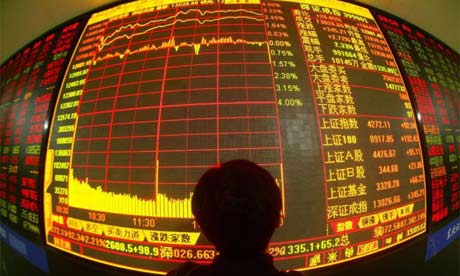 China’s manufacturing engine lost further momentum in July and the job market weakened, a survey showed on Wednesday, complicating a transition to consumer-driven growth and boding ill for so many leveraged to the world’s second-largest economy.
China’s manufacturing engine lost further momentum in July and the job market weakened, a survey showed on Wednesday, complicating a transition to consumer-driven growth and boding ill for so many leveraged to the world’s second-largest economy.
The knock-on effects are already being felt more and more widely — from a slowdown in Japanese export growth despite a weaker yen, to Apple lamenting a rare drop in Chinese demand for its premium brand of gadgets. “China’s slowdown is starting to become more dangerous,” warned Yasuo Yamamoto, a senior economist at Mizuho Research Institute in Tokyo. Since taking office in March, China’s new leaders have said they are prepared to tolerate tamer growth and push a restructuring of the economy toward domestic consumption, but there have been mixed messages on how much of a slowing they would tolerate. The flow of data suggests their task of changing the shape of the massive economy will only get harder. Wednesday’s flash HSBC/Markit Purchasing Managers’ Index showed output, employment and new orders all declining at a faster pace in July. The overall index of business conditions fell to 47.7 from June’s final reading of 48.2, a third straight month below the watershed 50 line which divides expansion from contraction and the weakest level since August 2012. The employment sub-index slid to 47.3 in July, the weakest since the depths of the global financial crisis in early 2009.
“This print could reignite fears of a Chinese hard landing,” said Annette Beacher, head of Asia-Pacific research at TD Securities in Singapore. “We expect economic growth to continue moderating towards 7 percent.”
China’s economy grew 7.5 percent in April-June from a year earlier, the ninth quarter of slowdown in the past 10 quarters.
While top leaders have stressed in recent weeks that reform is the priority, the latest being President Xi Jinping, they were also at pains to assure investors that Beijing would not allow the economy to slip too far.
On Wednesday the industry ministry said it was putting a priority on restructuring and reforming traditional industries such as steel, shipbuilding, cement and aluminium, once drivers of growth but now plagued with overcapacity.
A GLOBAL DRAG
Some analysts note that China is also hostage to the health of global markets.
“China cannot change its weak economic growth situation due to still weak external demand and overcapacity problems in the domestic market,” said Wang Jian, a senior researcher with the China Society of Macroeconomics, a research body affiliated with the National Development and Reform Commission (NDRC).
“China’s economic growth rate will probably fall below 7 percent in the fourth quarter this year and may fall under 6 percent in some quarter next year,” Wang wrote in the China Securities Journal on Wednesday.
While that is at the extreme end of market forecasts, China has become such a major importer of goods that any weakness in demand is increasingly felt worldwide.
Japan on Wednesday reported annual growth in its exports to China eased to 4.8 percent in June from 8.3 percent in May.
In the United States, Apple reported quarterly revenues from Greater China dived 43 percent from the previous quarter, to be down 14 percent from the same time last year.
That was an abrupt turnaround for the Silicon Valley giant which has come to count on endless growth in China. The country accounted for 13 percent of all the company’s sales in the quarter, up tenfold in just the past four years.
The same goes for commodity exporters. China consumes around half of the world’s iron ore and coal and 30 to 40 percent of global production of base metals such as copper.
London copper futures fell from one-month peaks in the wake of Wednesday’s data, while the Australian dollar took a knock as China is the country’s single biggest export market.
“It adds to the concern about the outlook for demand, and brings into question just how strong Chinese commodities demand will be,” said Alexandra Knight, economist at National Australia Bank.
Reuters















